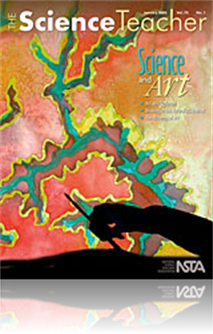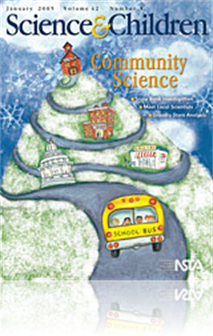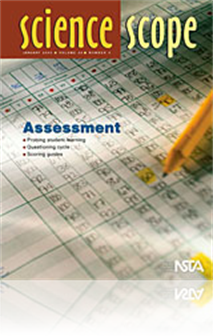All Resources
Journal Article
Writing and Drawing in the Naturalist's Journal
The mutually reinforcing integration of science and art is clearly seen in the journals and notebooks kept by creative thinkers and explorers since the time of Leonardo da Vinci. The Naturalist’s Journal is an effective tool for learning about natu...
Journal Article
In this section the editor discusses opportunities for teachers to demonstrate science concepts on the playground or in one's local neighborhood. The current journal issue is dedicated to finding and using these local resources, referred to as "Comm...
Journal Article
Formative Assessment Probes: Uncovering Students' Ideas in Science
Formative assessment probes can help teachers find out what students' ideas are before teaching lessons and use the information to adjust instructional strategies. This article defines formative assessment probes, provides examples of probes, and des...
Journal Article
Merging Science and Society: An Issues-Based Approach to Nonmajors Biology
The effectiveness of an issues-based approach to nonmajors biology was investigated. The integration of online critical-thinking exercises and in-class discussions of science-related issues did not improve exam scores. However, students did indicate ...
Journal Article
Editor's roundtable: Standard-izing test items (January 2005)
American Association for the Advancement of Science's Project 2061, one of the first organizations to focus on content standards and their role in curriculum, instruction, and assessment, is launching a new effort funded by the National Science Foun...
Journal Article
Editor's Corner: Making Sense of the World
In this month's Editor's Corner, the Field Editor paints a vivid word picture to describe the theme in this month's edition of The Science Teacher, which is the blending of art and science to help students make sense of the world. The overlap of art ...
Journal Article
Idea Bank: A Resonance Tube Experiment Using "Boomwhackers"
Bring the "sound of music" to your science classroom--this activity uses the lengths and fundamental frequencies of a set of resonance tubes to verify the expression for the relationship between these two quantities and the value of the speed of soun...
Journal Article
Science Sampler: Assessment for All
There are many ways of assessing students and the work they do, and many ways of getting them ready for those assessments. Special needs students provide an extra challenge to educators because they have difficulty communicating what they know. This ...
Journal Article
The experts address the following questions in this month’s column: If the scientific exploration of chemistry is still evolving, are there new elements still left to be discovered? If a new element were discovered, how would it fit onto the curren...
Journal Article
The Science Management Observation Protocol
Teachers often lack the procedural knowledge needed to manage a classroom where collaboration and scientific inquiry are emphasized. To combat this problem, a great deal of educational research has been devoted to the goal of identifying what makes a...
Journal Article
Idea Bank: Getting a Crack out of Ice
Why does an ice cube make a cracking sound when it is dropped in a glass of water? How can we make a louder cracking sound? Does the loudness depend on the temperature of the water? Can the cracking sound be eliminated? Does the shape of the ice cube...
Journal Article
Career of the Month: An Interview with Landscape Architect Brandon DeRosa
From planning the layout of a zoo to recreating wetlands impacted by a development project, landscape architects use a blend of science and art to design outdoor spaces. As a consultant for the restoration of natural sites, Brandon DeRosa strives to ...
Journal Article
Inquiry labs in the science classroom help students make connections and discover scientific relationships for themselves. This article describes an inquiry-based laboratory in which students explore the properties of a pendulum. This activity illust...
Journal Article
Inquiry in the Chemistry Classroom
A recent survey of high school chemistry teachers indicated that many teachers are not using inquiry labs in their classrooms. One reason is that although teachers understand the theory of inquiry, they lack practical experience developing and conduc...
Journal Article
Idea Bank: Diving Into Professional Development
The challenge of the Research and Education: Volcanoes, Exploration and Life (REVEL) Project, sponsored by the University of Washington School of Oceanography, is to teach, energize, and reinvigorate teachers, so that they can excite their students a...
Journal Article
The Virtual Gorilla Modeling Project (VGOR)—a professional development project—is a collaboration of middle and high school in-service teachers, Zoo Atlanta primatologists, science and computer educators, and students. During a 10-day professiona...
Journal Article
Astrobiology refers to the “origin, evolution, and distribution of life in the universe.” Astrobiologists study extreme environments on Earth and characterize the life forms that occupy them. These environments provide Earthly analogues to enviro...
Journal Article
Commentary: Taking Responsibility for Professional Development
The No Child Left Behind (NCLB) Act of 2001 contains numerous references to “high-quality professional development. The quantity and the quality of professional development are critical issues in the NCLB Act with direct impact on student achieveme...
Journal Article
Editor's Corner: Learning to Like Professional Development
Science teachers today face unprecedented opportunities for professional development. From genomics to planetary exploration, new scientific discoveries are announced almost daily, discoveries that are changing our basic understandings of nature. New...
Journal Article
Teachers can easily identify what subjects their students have trouble with, whether it is transcription and translation, glycolysis and fermentation, balancing chemical equations, or vector analysis of forces acting on an object. This article descri...
Journal Article
Focusing Labs on the Nature of Science
After learning about the scientific method, students are often left with mistaken impressions about how scientists work. This article seeks to give students a better understanding of the nature of science through laboratory work. Open-ended exercises...
Journal Article
In contrast with statements by institutions and science organizations about why science should be studied, nonscience majors at two- and four-year institutions said they were enrolled in a science course because it was required rather than because it...
Journal Article
Incorporating History into the Science Classroom
The use of history in science courses can humanize science, help students refine their critical thinking skills, promote a deeper understanding of scientific concepts, and address common student misconceptions that often resemble those of past scient...
Journal Article
The authors conducted a research case study to ascertain the effect of a bridge program on fostering self-growth and academic readiness for college. Academic wholism provided the vehicle to promote self-awareness, self-motivation, and academic maturi...
Journal Article
Point of View: Mommy Love and the Sciences
At the university level, instructors who embody Mommy-love give high marks for effort, are very charismatic, and often have a large and vocal following of dedicated students. However, the science faculty is more likely to be populated by Daddy-love i...
Journal Article
Tech Trek: A different phase change
In physical science, we often use water to demonstrate change of state. However, this teacher demonstration will expose students to unfamiliar substances whose phase changes can be compared to those of water. Subsequently, a phase change that is in r...
Journal Article
Writing, in conjunction with other activities such as reading and hands-on experiences, contributes to greater critical thinking, thoughtful consideration of ideas, and better concept learning. This article discusses a comprehensive approach toward s...
Journal Article
Keys to Teaching the Nature of Science
Despite continuous and well-reasoned recommendations that students need to have an understanding of science as a human endeavor and the nature and history of science across all grade levels, some students and teachers alike still fail to understand e...











